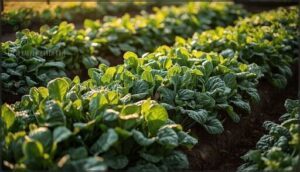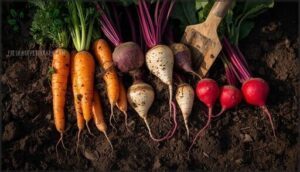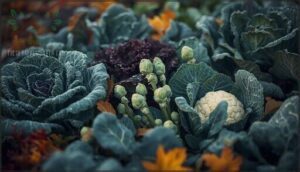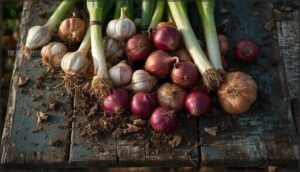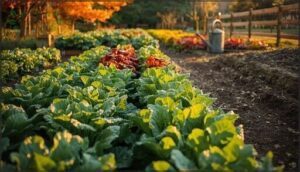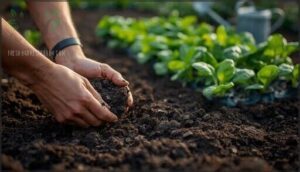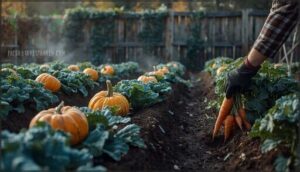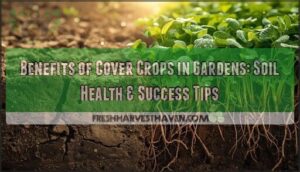This site is supported by our readers. We may earn a commission, at no cost to you, if you purchase through links.
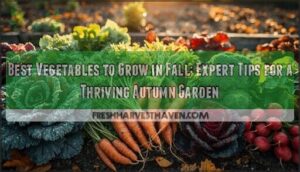
While your neighbors are watching bare beds, you can harvest crisp lettuce, candy-sweet carrots, and tender broccoli well into winter. The secret isn’t luck or a greenhouse. It’s choosing the right crops and timing your planting to match autumn’s rhythm.
With frost dates calculated and cold-hardy varieties selected, your fall garden can outperform the spring plot that everyone celebrates.
Table Of Contents
- Key Takeaways
- Top Vegetables to Grow in Fall
- Choosing The Right Fall Varieties
- Planning Your Fall Vegetable Garden
- Preparing Soil and Planting Techniques
- Extending and Harvesting The Fall Crop
- Frequently Asked Questions (FAQs)
- What is the best vegetable to plant in the fall?
- When should I start my fall garden?
- What vegetables are good in the fall?
- What is the best vegetable to grow in autumn?
- What is the best vegetable to plant in autumn?
- Is September too late to plant fall vegetables?
- What plants are best to plant in the fall?
- What is the best vegetable to grow in the fall?
- What vegetables are best to plant in the fall?
- What are the best vegetables to plant in fall?
- Conclusion
Key Takeaways
- Fall’s cooler temperatures and consistent moisture create better growing conditions than summer for dozens of vegetables, with many crops like carrots and kale tasting sweeter after frost due to increased sugar content.
- Success hinges on calculating your first frost date and counting backward 6-8 weeks to establish planting windows, with cold-hardy varieties like spinach, brassicas, and root vegetables thriving through winter when paired with season-extension tools like row covers and cold frames.
- Fast-maturing crops like radishes (22 days), Swiss chard (30 days), and baby carrots (45 days) deliver quick harvests even when planted in September, while garlic planted in fall requires minimal effort and produces abundant summer yields.
- Proper soil preparation with 25 pounds of compost per 100 square feet and precise seed depth (never exceeding twice the seed’s diameter) boosts germination rates by 15-25%, while organic mulch at 3-6 inches cuts irrigation needs by 30% and extends production weeks beyond the first frost.
Top Vegetables to Grow in Fall
Fall brings a whole new lineup of vegetables that thrive when the weather cools. If you’re wondering what will flourish in your autumn garden, you’ve got plenty of options.
Let’s look at the top picks for a strong, productive season.
Leafy Greens for Cool Weather
Spinach, kale, and lettuce are your go-to cool weather greens—true champions for fall gardening. These leafy greens thrive as temperatures drop, sweetening after a light frost and packing in nutrients.
If you want a nutrient-dense harvest, try cold-hardy varieties like Swiss chard or arugula. Smart leafy crop selection means fresh salads and steady greens all autumn long.
For ideal growth, understanding cool season greens is essential for a thriving autumn garden.
Root Vegetables Ideal for Autumn
Once your greens are settled, root crop selection steps up as the backbone of cool season farming. Carrots, beets, turnips, and radishes thrive in autumn soil prep, sweetening after frost and packing in flavor.
For fall gardening tips, sow carrots and beets 10–12 weeks before frost. With smart planting of cool-season vegetables, you’ll enjoy fresh roots and easy vegetable storage all winter. Understanding the cool season crops is key to a successful autumn garden.
Brassica Family Favorites
Now, if you’re craving hearty nutrition and low-fuss harvests, brassicas are your ticket. Broccoli, kale, cabbage, cauliflower, and Brussels sprouts thrive in cool-season beds, sweetening after frost and packing antioxidants.
Kale benefits especially shine after a cold snap. With careful cauliflower care and smart choice of broccoli varieties, you’ll grow flavor, savings, and resilience.
Alliums and Bulb Vegetables
If you want a fall garden with punch, don’t overlook alliums—garlic, onions, and leeks. Fall planting sets these bulbs up for strong roots and a summer Garlic Harvest. With smart Bulb Care and attention to Allium Diseases, you’ll reap:
- Reliable Onion Varieties for winter storage
- Leeks that thrive in cool soil
- Garlic’s superior yield and flavor
Fast-Maturing Fall Crops
If you’re impatient for results, several fast-maturing varieties deliver a bounty before frost even whispers. Quick picks like radishes and bush beans thrive with rapid growth methods—perfect for autumn gardening tricks. Cool season crops like baby carrots and Swiss chard race from seed to plate.
Here’s a handy table for your fall harvest tips:
| Fast-Maturing Varieties | Days to Harvest |
|---|---|
| Radishes | 22 |
| Bush Beans | 60 |
| Swiss Chard | 30 |
| Baby Carrots | 45 |
| Peas | 55 |
Choosing The Right Fall Varieties
Picking the right fall varieties can make all the difference in your autumn harvest. Some vegetables handle cold snaps and shorter days better than others.
Let’s look at the best options to set your garden up for success.
Frost-Tolerant Vegetable Options
Ever seen kale shrug off a deep freeze like it’s nothing? That’s the magic of frost-tolerant vegetables. Cold Hardy Vegetables such as cabbage, leeks, and spinach keep thriving when others tap out.
With frost protection fabric or a cold frame, your cool-season crops—think leafy green vegetables and Frost Resistant Crops—can push through winter, making Winter Vegetable Gardening truly rewarding.
Best Varieties for Shorter Days
Short days don’t mean short on harvests. Cool Season Varieties like ‘De Cicco’ broccoli and ‘Skywalker’ cauliflower thrive in Low Light Gardening, pushing out heads even with just 8–10 hours of daylight. Radish ‘Cherry Belle’ matures in under a month.
Choosing fall vegetable varieties with proven Short Day Crops ensures your Autumn Harvesting keeps rolling after Fall Planting.
Selecting Seeds for Overwintering
Think your fall garden’s done when the frost hits? Not even close. Overwinter strategies start with picking seeds that promise top germination rates and true cold tolerance. Frost-hardy favorites like ‘Red Russian’ kale and ‘Winter Giant’ spinach keep going when others quit.
For seed viability, store cool-season crops dry and cold. Vernalization techniques trigger spring blooms from biennials—don’t skip them.
High-Yield Fall Crops
Want the biggest bang for your garden buck this fall? Focus on high-yield vegetables that thrive in cool weather and reward good soil preparation and crop rotation.
For yield optimization and easy fall harvesting, plant these winners:
- Leafy greens—lettuce and spinach deliver multiple cuttings.
- Root vegetables—carrots and beets pack dense productivity.
- Brassicas—broccoli and cabbage excel in autumn’s cool embrace.
Planning Your Fall Vegetable Garden
Getting your fall garden off to a strong start means thinking ahead and working with the season’s quirks. There’s a handful of strategies that can help you make the most of your space and timing.
Here’s what to keep in mind as you map out your autumn planting plan.
Calculating First Frost Dates
Your fall garden’s success hinges on nailing those frost date calculations. First frost usually hits when there’s a 50% probability of temperatures dropping to 32°F, but smart gardeners use the 10% probability date for a two-week safety buffer. Climate trends show frost-free periods have lengthened by 10 days over the past century, giving you more wiggle room.
| USDA Zone | Average First Frost | 10% Probability Date | Planting Window |
|---|---|---|---|
| Zone 5 | October 17-21 | Early October | Mid-August start |
| Zone 6 | October 17-31 | Mid-October | Late August start |
| Zone 7 | Late October | Early November | Early September |
| Zone 8 | Mid-November | Late November | Mid-September |
| Zone 9 | Mid-December | Late December | Early October |
Temperature forecasting isn’t just about averages—altitude changes of 1,000 feet can shift frost dates earlier by three days. Coastal areas enjoy up to four weeks longer than inland spots at the same latitude. Weather patterns and urban heat islands can delay frost onset, but don’t get cocky. Use conservative frost probability windows when planning your frosthardy crops, and you’ll have fresh vegetables dancing through autumn’s chill.
Succession Planting Strategies
Once you’ve pegged your frost dates, boost your fall garden with succession planting and smart harvest scheduling. Tight planting intervals—think leafy greens or radishes every week, carrots or kale every three—let you harvest cool-season crops in steady waves.
Pair these with crop rotation and sharp soil management, and you’re optimizing yield while keeping your autumn beds working overtime.
Maximizing Limited Sunlight
Whether you’re working with a balcony behind tall buildings or a plot hemmed in by trees, don’t let limited sun exposure shade your ambitions. Cool-season crops like leafy greens and Brassica oleracea var. italica thrive with a touch of shade. Optimize every ray using reflective mulch, clever garden orientation, or even supplemental lighting—small choices make a big difference for your fall vegetables.
- Orient beds east–west for steady sunlight
- Plant tall crops on the north side to avoid shade on small veggies
- Use reflective mulch for light enhancement
- Try shade-tolerant greens for stubbornly dim spots
- Invest in supplemental lighting if you’re growing indoors
Companion Planting for Fall
After you’ve finagled every last ray from shady corners, real magic comes from pairing fall garden allies together. Smart companion planting means less trouble—marigolds cut down nematodes, garlic and alliums repel pests, and peas ramp up soil health for cool-season crops.
Try these combos for companion planting benefits that go beyond tradition:
| Crop Pair | Benefit | Bonus Effect |
|---|---|---|
| Broccoli & Dill | Pest Deterrents | Season Extension |
| Peas & Spinach | Soil Health | Frost-tolerant Vegetables |
| Marigolds & Kale | Pest Control | Crop Rotation Simplicity |
Preparing Soil and Planting Techniques
A healthy fall garden starts from the ground up—literally. Get your soil in top shape and fine-tune your planting approach now to reap steady rewards later.
Here’s what you’ll want to focus on as you prep and plant this season.
Improving Soil Structure for Fall
Think your beds are just dirt? Soil structure is the secret workhorse, shaping how plants thrive. To boost soil aeration and keep compaction at bay, I recommend:
- Layering organic amendments for aggregate formation,
- Avoiding tillage when wet,
- Letting fungal networks flourish.
Know your soil type and check Soil pH—well-draining soil pays off all season.
Organic Matter and Fertilization
Nutrient cycling transforms fall gardens when you feed soil microbes first, not plants. I broadcast compost at 25 pounds per 100 square feet three weeks before planting—this allows microbes to mineralize nitrogen into usable forms.
Blood meal (12.5% nitrogen) or balanced organic 8-8-8 fertilizer supplies what cool-season crops crave.
Fall-applied organic amendments raise your soil’s carbon by 15–30% annually, building fertility that outlasts any quick-fix synthetic.
Correct Seed Depth and Spacing
Precision in seed sowing techniques transforms guesswork into reliable germination rates. Plant lettuce and celery seeds just 0.25 inches deep, while spinach thrives at 0.5–0.75 inches—anything deeper cuts emergence by 15–25%.
Space carrots 1–2 inches apart and broccoli 18–24 inches to avoid competition.
The golden rule: never exceed twice the seed’s diameter for depth, and adjust upward 25% in dry autumn conditions to reach consistent soil moisture.
Mulching and Irrigation Tips
With mulches, you’re slashing water needs while protecting your fall crops. Organic mulch—shredded leaves or straw at 3–6 inches—cuts irrigation by 30% and keeps soil moisture stable for days. Drip irrigation systems save up to 60% more water than overhead sprinklers, delivering moisture directly to roots.
Layer compost as mulch for dual benefits: water efficiency jumps 20% and soil structure improves. Apply mulch after soil preparation to lock in moisture and shield against frost.
Extending and Harvesting The Fall Crop
You’ve put in the work to establish your fall crops, but the real payoff comes when you protect them from harsh weather and harvest at just the right moment.
Season extension tools and smart timing can stretch your garden’s productivity well into winter—or even through it.
Here’s how to make the most of your autumn bounty.
Using Row Covers and Cold Frames
When frost threatens your fall garden, row covers and cold frames become your front-line defense for extending the growing season. Lightweight row covers transmit 80–90% of sunlight, while medium-weight versions provide 4°F–6°F of frost protection—enough to shield cool-season crops through early autumn freezes.
Cold frames take microclimate control further, maintaining nighttime temperatures 10°F warmer than outside air and reducing irrigation needs by 30%. Together, these season extension tools can boost yields by 35% and push production several weeks beyond your area’s first frost date.
Timing Harvests for Peak Flavor
You don’t want to harvest too early or too late—timing is everything for peak flavor. Carrots and beets grown through light frost develop 20% more sugar content, sweetening as temperatures drop.
Broccoli hits its nutrient peak around developmental stage 3 to 4, when glucosinolates and vitamin C converge. Mature kale leaves pack 25% more beta-carotene than younger growth, deepening flavor.
Understanding maturity dates and frost impact ensures you’re harvesting fall crops at their absolute best.
Storing and Preserving Fall Vegetables
Once you’ve mastered harvesting fall crops, proper storage keeps your bounty fresh for months. Cold storage excels for root vegetables—storage carrots, beets, and turnips last eight months at 0–4°C with 95% humidity. Freezing methods retain up to 97% of vitamin C in broccoli when stored at −18°C, while dehydration tips include maintaining 80–90% fiber despite 30% vitamin loss. Canning safety demands pressure canning for low-acid vegetables to prevent botulism. Choose preservation based on nutrient retention goals:
- Store winter roots in humid, near-freezing conditions for maximum longevity
- Freeze blanched vegetables within hours of harvest to lock in nutrients
- Ferment at 1.5–3 tablespoons salt per quart for one to two years of shelf life
Managing Pests and Diseases in Autumn
Your vegetables need protection now—aphids reproduce in just seven days, and cabbage loopers can strip brassicas in a week. Autumn Sanitation is your first defense: remove all diseased debris to eliminate overwintering pathogens.
Biological Interventions like floating row covers prevent 75% of pest eggs, while hand-picking slugs beats chemicals. Integrated Management combines these tactics, cutting disease incidence by 46%.
| Pest Control Methods | Disease Prevention |
|---|---|
| Row covers block egg-laying | Remove infected plants immediately |
| Hand-pick cabbage loopers | Apply fungicides at first leaf spot |
| Diatomaceous earth stops slugs | Manage weeds to reduce pest habitat |
Frequently Asked Questions (FAQs)
What is the best vegetable to plant in the fall?
Garlic’s your secret weapon—plant it once in fall, forget it, and harvest a summer bounty with minimal fuss.
For cool-season crops like spinach, kale, or carrots, you’ll optimize your fall garden planning by choosing frost-tolerant varieties suited to autumn’s shorter days. Crop rotation and solid soil preparation set you up for perfect harvest timing.
When should I start my fall garden?
Your fall garden planning starts with frost date calculation—count backward 6-8 weeks from your first expected freeze to establish planting dates.
Cool-season crops need this window for garden readiness assessment, with season extension methods adding flexibility to fall planting schedules.
What vegetables are good in the fall?
Cool-season crops thrive when temperatures drop—leafy greens like spinach and kale, root vegetables such as carrots and beets, and brassicas including broccoli and cabbage all excel in autumn.
Planting cool-season vegetables ensures winter harvesting techniques deliver fresh produce through cold months.
What is the best vegetable to grow in autumn?
If you’re wondering which autumn garden addition brings the most reward for your effort, garlic stands out as a top performer. This cool-season crop delivers outstanding yield with minimal labor, thriving in cooler temperatures while requiring less attention than most fall vegetables. Plant it now for a bountiful summer harvest.
What is the best vegetable to plant in autumn?
For autumn crop selection, garlic stands out as your most reliable choice for fall planting. You’ll plant cloves now and harvest sturdy bulbs next summer—garlic thrives in cool weather crops.
Radishes and spinach also deliver quick results, maturing in just 30-40 days for your fall harvest tips.
Is September too late to plant fall vegetables?
Absolutely not—September is prime time for cool season crops. With quick-maturing vegetables like radishes, spinach, and lettuce, you’ll harvest before frost hits.
Just choose frost-tolerant varieties and nail your first frost date for autumn harvesting success.
What plants are best to plant in the fall?
The best choices for fall planting include leafy greens like spinach and kale, fast-maturing root vegetables such as radishes and turnips, and cold-hardy brassicas including broccoli and cabbage.
All of these thrive as cool-season crops with excellent frost tolerance.
What is the best vegetable to grow in the fall?
You’ll never believe this, but kale is hands down the best fall veggie to grow. It’s a beginner-friendly crop that thrives in cool-season conditions, with light frosts actually sweetening the flavor.
This space-efficient vegetable tolerates temperatures down to 15°F and delivers consistent harvests throughout your fall harvest season.
What vegetables are best to plant in the fall?
Your best bets for fall planting include cool-season crops like kale, spinach, and lettuce—leafy greens that thrive when temperatures drop.
Root vegetables such as carrots and beets sweeten after frost, while broccoli and other brassicas handle autumn weather beautifully.
What are the best vegetables to plant in fall?
When the heat waves goodbye, your garden gets a second wind—cool-season veggies thrive in fall’s crisp embrace.
Plant leafy greens like kale and spinach, root vegetables such as carrots and beets, brassicas including broccoli and cabbage, plus garlic for next summer’s harvest.
Conclusion
Picture a seasoned gardener kneeling in October soil, pulling carrots that snap clean and taste like candy—something their July harvest never achieved. That’s the quiet reward waiting for you. While others watch their yards fade, you’ll understand that fall isn’t a retreat; it’s when deliberate growers stack their tables with the best vegetables to grow in fall.
Your timing, variety choices, and soil work will determine whether you’re eating fresh greens in December or scrolling through grocery aisles. The season doesn’t close when temperatures drop—it opens for those who planted with intention.

